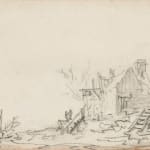Jan van Goyen (1596 – 1656)
Further images
Jan van Goyen travelled the length and breadth of the Netherlands recording details of landscape and topography in black chalk. A small sketchbook tucked into his pocket, the draughtsman in search of inspiration could quickly delineate sand dunes and architectural structures in the vicinity of his hometown or on extended journeys to France or Germany. Back in his studio, the sketches would provide endless creativity, combining different motifs into realistic or imaginary landscape compositions. These drawings not only functioned as preliminary studies for motifs in paintings, Van Goyen at times also reworked them into larger, more finished drawings, typically monogrammed and dated, intended for sale. Never attempting to depict accurate views, Van Goyen’s preliminary studies unfold as topographical elements in his scenery.
The following drawing originates from a now dispersed sketchbook fifty-four-year-old Jan van Goyen took along on a trip to Kleve, starting on 7 June 1650. After his return to his hometown, The Hague, the remaining pages in the sketchbook were filled with shorter trips, including a visit to Amsterdam. Traveling by boat, the artist recorded the disaster caused by the infamous breach of the Saint Anthony’s dike at Houtewael on 5 March 1651, and the old Town Hall, destroyed by fire the following year. Although the exact location of this windmill is unknown, from the sequence of drawings in the sketchbook it can be concluded that the artist’s is moving around Amsterdam from a low perspective on the water, making stops at bustling markets.
In the night of 5 March 1651, the streets of Amsterdam and beyond were flooded, inspiring many artists to memorialize the devastation. A spring tide at full moon caused the Sint Anthonis dike to break through, flooding the Diemermeer which had been drained in 1629, creating major damage in Amsterdam. At least nineteen leaves in Van Goyen’s sketchbook document the catastrophic tragedy, further evidence that the artist travelled to Houtewael immediately following the breach. Such cataclysms provided popular subject matter in the seventeenth century and artists would often fill the demand of the art market by disseminating the news through prints and paintings. Van Goyen would use the sketches to produce slightly larger, finished drawings of the disaster area.
Other drawings from the present sketchbook are now in the collections of The Rijksmuseum, Amsterdam City Archives, Amsterdam, Teylers Museum, Haarlem, Fondation Custodia/Collection Frits Lugt, Paris, Nationalmuseum, Stockholm, Art Museum, University of Toronto, The Metropolitan Museum of Art; The Morgan Library & Museum, New York, Smith College Museum of Art, Northampton, Art Institute of Chicago, Fogg Museum/Harvard Art Museums, Cambridge, Allen Memorial Art Museum, Oberlin, The Museum of Fine Arts, Houston, The Frances Lehman Loeb Art Center at Vassar College, Pougkeepsie, The National Gallery of Art, Washington, and in numerous private collections.
Provenance
Possibly Andrew Geddes (1738-1844), London, 1845 His sale, Christie's, London, 8-14 April 1845, lot 361 Private collection, England, 1879Johnson Neale, London, by 1895
Thomas Mark Hovell (1853-1925), London, June 1918
Thomas Dinwiddy
His sale, Sotheby's, London, 3 July 1918, lot 124 (£610)
With P. and D. Colnaghi & Obach, London (stock no. A1700) Frederik Muller & Cie, Amsterdam, 15 August 1918 (sold for £800) With Anton Mensing (1866-1936), Amsterdam
His sale, Frederik Muller & Co., Amsterdam, 27 April 1937, lot 218 (for 7,200 florins to Hirschmann4) With Adolf Mayer, the Hague and New York
With Van Diemen-Lilienfeld Galleries, New York, 1957
C.F. Louis de Wild, New York
N.L.H. Roesler, New York
His sale, Christie’s, New York, 31 May 1990, lot 80
Christie’s, London, private sale, 2014
Private collection, New York
Exhibitions
The Hague, Mauritshuis, 1895The Hague, Mauritshuis, 1918
Literature
Verslagen omtrent ‘s Rijks Verzamelingen van Geschiedenis en Kunst, Vol. 18, 1895-1896, pp. 64-66
Campbell Dodgson, ”A Dutch Sketchbook of 1650”, Burlington Magazine, Vol. 32, no. 183 (June 1918), pp. 234-240
Abraham Bredius, in response to Campbell Dodgson, “A Dutch Sketchbook of 1650,” Burlington Magazine, Vol. 33, no. 186, (September 1918), p. 112
Campbell Dodgson, “A Dutch Sketchbook of 1650,” Burlington Magazine, Vol. 66, no. 387 (June 1935), p. 284
Hans-Ulrich Beck, ”Jan van Goyens Handzeichnungen als Vorzeichnungen”, Oud-Holland, Vol. 72, 1957, pp. 241-250
Friedrich Gorissen, Conspectus Cliviae, Cleve, 1964, p. 84-86
Hans-Ulrich Beck, Ein Skizzenbuch von Jan van Goyen, The Hague, 1966, p. 5
H. Dattenberg, Niederrheinansichten holländischer Künstler, Düsseldorf 1967
Hans-Ulrich Beck, Jan van Goyen, 1596-1656: Ein Oeuvreverzeichnis. Katalog der Handzeichnungen, Vol. I, Amsterdam 1972, cat.no. 847/179, p. 309, ill.
Hans-Ulrich Beck, Jan van Goyen, 1596-1656: Ein Oeuvreverzeichnis. Erganzungen zum Katalog der Handzeichnungen, Vol. III, Doornspijk 1987, cat.no. 847, pp. 124-125b
Edwin Buijsen, ”De schetsboeken van Jan van Goyen”, in: Jan van Goyen, Leiden 1996, pp. 22-37, 80, 130
Ann H. Sievers, Master Drawings from the Smith College Museum of Art, New York 2000, pp. 65-69, nos. 12-13





